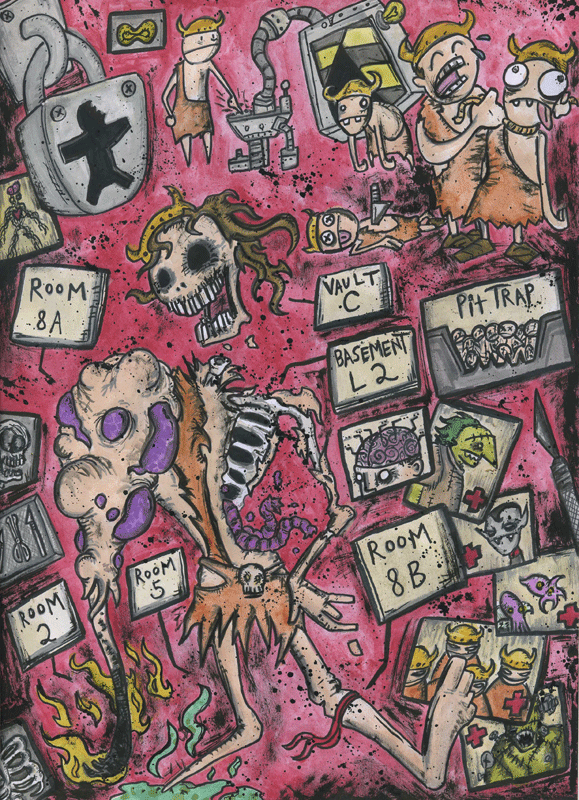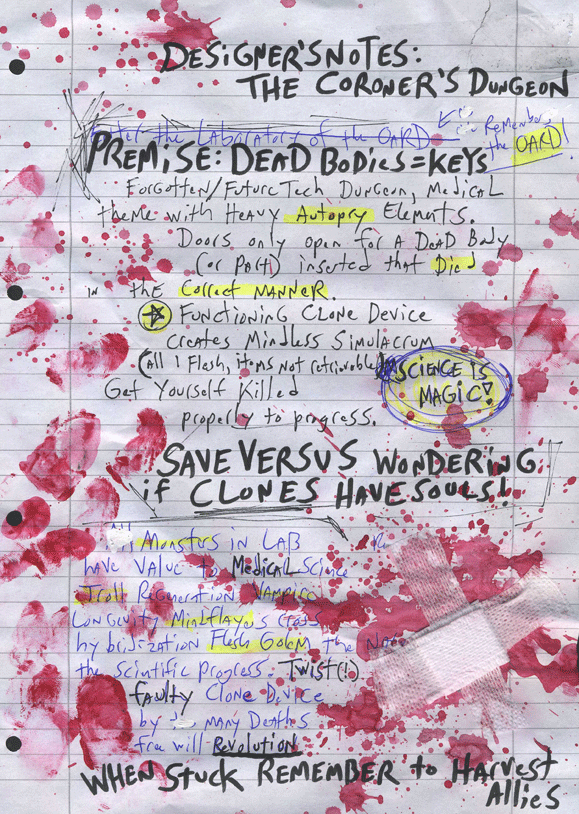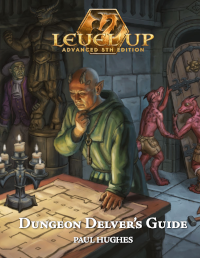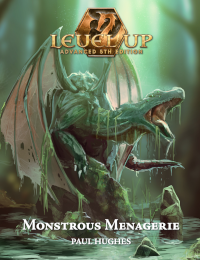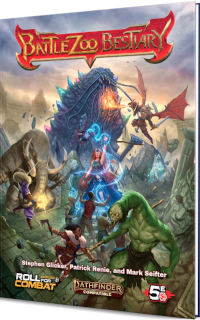Mike Mearls answered D&D questions on Reddit last week. He answered over 100 questions. In this post, I’m not providing a full transcript: we already know that Next is going to be modular, that they want our feedback, and that Mike has a charming personality. Here, I’m just including the Qs and As that reveal new game rules information about D&D Next.
GokaiCant: I loved the advantage mechanic at first glance, looked like a really elegant way of handling attack bonuses and penalties. Until I had to make 36 rolls a turn for some mice. What approach, if any, will D&D 5e take to make Advantage/Disadvantage bearable with large encounters?
mikemearls: Ah yes, the rats. Sometimes, playtests reveal subtle issues. Other times, they hit you over the head.
This is a pretty big issue, because the monster design is aiming to keep hordes of orcs/goblins/etc a viable threat at high levels. So, at level 1 it might be 18 rats, but at level 10 it might be 18 orcs.
I’d like to incorporate a core “swarm” rule into the game, an easy way for DMs to group up monsters into single attacks. For instance, something that lets you combine X attacks into one die roll, with some small amount of damage even on a miss to make that an appealing option.
Hopefully, that solves the rat issue and also the humanoid horde issue at higher levels.
themanwhowas: Are you actually going to include modules for 4E fans who want flexible, intelligent, veteran fighters? With maneuvers, combinations and techniques like real swordsmen? Powers that are designed by game designers to be balanced as well as fun? That give consistency across tables, sessions and DMs? Or are we going to be forced to settle for dumb-as-brick fighters because that’s what the old guard want for nostalgia’s sake?
Question 2: On a similar note, encounter powers can make a lot of sense in-game. Tricks you can only pull once before enemies become prepared for it, like sand in the eye, trips, taunts, unexpected maneuvers and so on. Is there going to be a module that includes these, not just for fighters but for other classes as well? And don’t say I can improvise them already, I want mechanics that I can rely on.
mikemearls: Fighters – We have a maneuver system in design that we’re playtesting here in the office. In my Monday game, Chris Perkins’ fighter could choose between an inaccurate but high damage attack, a defensive attack that force an enemy to pay attention to him, and a second defensive option that boosted his AC. That’s just the surface of what we have going on in there.
I’d also like to extend the maneuver idea to other areas of the game – social maneuvers, rogue tricks, things like that. Our goal is to make a wide variety of characters possible, rather than stick each class into a limited box. Just as we’re moving roles out of class, we’re also moving complexity limits out of class as much as we can.
Encounter Powers – We’re looking at a mechanic that draws on the idea of pushing yourself beyond your limits between rests, basically a stamina-based mechanic. This is precisely the kind of more complex option that we place in the game for players who want to take on that sort of approach.
SleepyFingers
How does D&DNext plan to balance magical and non-magical classes and avoid caster-supremacy?
Also, on another note, I’ve heard that skills are almost non-existant as of the current builds and might just be a module that comes out. I know that skills is the hardest point to do because it lacks any consistency across editions, but the taking away of skills seems to put a huge focus on combat, which can be a bad thing. Though you probably don’t want to speak too concretely, I’d like to know what the current plan for skills actually is.
mikemearls: For caster supremacy, the key lies in attacking it from both ends. We can do a lot by reining in the most abusive spells and making it harder for casters to chain things together in abusive combos. The other end is making sure that we make an honest comparison of the casters to the non-casters.
For instance, if a wizard can turn invisible we have to be cool with rogues having an almost entirely assured chance of success to hide or sneak up on people. It’s unbalanced if the guy who is supposed to be stealthy has a real chance of failure, while the wizard’s magic has 100% chance of success of turning someone invisible.
For skills, we definitely will have them in some form to give people pointers to the non-combat stuff they are good at. Right now, classes give skills as appropriate but most of your skills come form your background. Backgrounds are not linked to class, so a fighter can choose the criminal background to become stealthy or good at picking locks.
The key discussion we’re having right now with skills boils down to this – does a skill make you better than you otherwise would be at something, or does it make you strictly good at it?
Making you better would be a +3 bonus, which is then stacked on top of an ability modifier. So, a Wis 9 rogue (ahem) would be better at finding traps, but still only at +2.
The second path removes abilities from the equation. The rogue would just have +5 to find traps. You’d use either an ability mod or your skill, rather than stacking them.
We’ve been arguing back and forth on which path works better. Neither has emerged as a clear front runner.
beckermt: With the return of Vancian casting are you planning on giving non-magical characters some sort of “pull out the stops” type of abilties?
I know the fighter has twice per day do 2 actions, but that’s not… you know, exciting, per se. The magic stuff allows casters to perform new and different abilities, even at a limited level.
Second Question: Is there any intention to add a Attacks of Opportunity system or somesuch to give players a more effective way to control the battlefield?
mikemearls: Yes, we’re looking at a set of maneuvers that characters can dip into to gain more concrete options in fights, along with options that you can use to push yourself beyond your limits for an action or two per encounter.
We’re strongly considering adding a free attack if someone breaks away from a melee. The playtest feedback has been a little soured on letting people move around without consequence. However, the rule would be much simpler than attacks of opportunity – likely it’ll be that if you start your turn in someone’s reach, they get an attack on you if you try to leave their reach using an action to withdraw.
Keep in mind that our goal for adding a mechanic like this would be to keep it very, very simple. We are 100% NOT going to give you a long list of things that provoke. It would be moving away from an enemy and nothing else.
SergioSF: Can you give us just a tid bit about bards?
mikemearls: The first pass on bards is going back to their Celtic roots while also looking at making a jack of all trades mechanic that doesn’t make the bard second best at everything. It’s still early, and the final design might be much different, but I really want to give the bard something unique that really speaks to their roots.
HighTechnocrat: With the limited numerical advantages gained by advancing in level, how will high level characters still feel the difference in power when they face foes which were a challenge at previous levels?
mikemearls: We’re working on higher level play in concert with our monster design, but you can expect that each class will have some built-in abilities that help them deal with greater numbers of foes and single, more powerful enemies.
For instance, fighters might have a mechanic that lets them hit several weak enemies at once at the cost of reduced damage. That doesn’t work so well against giants, but it lets a higher level fighter take down numerous, lower-level foes.
OTOH, a rogue might just get better at backstabbing or dueling one guy. It depends on the class’s identity and how we see it interacting with hordes of weaker enemies.
Armored-Saint: A common complaint on the discussion boards is that heavy armor isn’t effective enough when compared to light armor + Dexterity modifier. What plans, if any, are in the works to address this concern?
mikemearls: We’re completely re-working armor. We’re bulking up heavy armor, giving medium armor a better definition, and slightly pulling back on light armor.
Heavy armor allows no Dex bonus but has a high base value. Heavy armor always gives disad on attempts to be stealthy.
Medium armor has +2 Dex max or no Dex allowed. It sits below heavy armor. Classes like the ranger and barbarian are proficient with it. Some medium armors give disad on checks to hide or move silently. Basically, if you play a ranger or barbarian, you can either junk Dex and take a “heavier” medium armor or take a lighter one that lets you be stealthy.
Light armor allows full Dex and has no stealth drawbacks.
Rajion: 1) How much will coins weigh in the next edition? Or will the weight of coins be ignored, like sheets of paper?
2) If they will have weight, will the different varieties of coins have different weights, or will they have the same weight?
3) Will Platinum coins go back to a worth of 10 gold coins like in 3.5, or will they remain equal to 100 gold coins like in 4.0?
mikemearls: 1. Coin weight will likely be X coins/pound.
2. Likely they will all be the same.
3. I believe they are at 10 gold per platinum right now. You can expect a flatter wealth level for characters in 5e.
liblarva 1. Is there any other way to handle humans than the apparent +1 to all stats? It seems rather OP considering the new focus on abilities.
2. Will martial maneuvers be open to all, or limited to fighters? I ask because making subsystems for one or a handful of classes seems like a waste when the fighter can be given a simple bonus to these maneuvers rather than a unique subsystem. Similar to how classes shared spells in prior editions.
mikemearls: 1. Classes also give ability bonuses, so the ideas is that a human is more balanced than other races and that the other races are a little more focused vs. the generalist human.
2. Anyone can take maneuvers.
CastleCrasher Hey, I played the playtest with a couple friends of mine last weekend and we had a blast! My one question regards healing. I liked most of the mechanics, but I felt like the human cleric couldn’t quite heal enough. I was wondering what your thought process behind the healing kit was, and why you decided to make it an item instead of a class ability.
mikemearls: The idea behind making it an item was to make it something anyone could take. One direction we’re thinking of taking is making a cleric’s healing a separate ability from spells, so that we can give more healing without also having to give more spells in total.
cr0m: Hi Mike,
I’m one of the founders of Red Box Vancouver and a big fan of Basic D&D, so I’m loving the playtest rules–especially the choice of adventure!
Are there any plans for adding monster reaction tables or morale? They’re one of my favorite parts of the old school games. The first one really helps with sandbox play/improv and the second really speeds up combat.
mikemearls: Yup, you can expect both in rules modules. I wrote a set of morale rules for tactical play, and I expect we’ll include reaction tables for our interaction mechanics.
clue_bat: If most of a class’s cool abilities are in the first 3 levels (Rule of Three), might we see a return of 3.5’s level dipping? I’m sure we all remember characters that looked like this:
Fighter 4 / Ranger 2 / PsyWar 3 / Monk 2 / PrcA 2 / PrcB 3
mikemearls: We want to go back to 3e multiclassing, but I think we learned some very valuable things from the hybrid system in 4e.
deathdonut: 1. How do you plan to balance magic item stacking?
2. Will it be possible to permanently increase a stat?
3. Will magic users have items that directly increase their abilities in a way that corresponds to magic weapons for melee?
4. Is there thought given to the “budget” that different class styles will need to spend on equipment to keep up with the balance curve?
mikemearls: 1. We’re hoping to avoid +X items outside of armor, weapons, and shields.
2. Yes.
3. We’re looking to keep implements as items that increase spell accuracy/save DCs.
4. We’re actually looking at making buying equipment optional. Instead, you are given a starting package based on background and class.
shimmertook: How many levels is the current playtest model giving for a character’s entire career?
mikemearls: We’re looking at capping at level 20, but giving a set of options for uncapped advancement beyond that.
PrinceAuryn: How are magic items handled in DnDNext? Will we see a return to awesome extra damage, or will they say “super balanced” and +1 to hit.
mikemearls: We want magic items to feel awesome. I want the +1 or +2 to be something that you might even gloss over, and part of me wants to try designing the game without them.
I’d much rather have a hurricane flail that generates buffeting winds, knocks arrows out of the sky, and summons an air elemental than a +1 weapon. Key is – how many people agree with that? Are +X weapons/armor/etc iconic to D&D?
That said, I think we can have both. We’ll likely limit the maximum plus you can get, and we can then simply start with interesting/cool items and add pluses to those.
MindWandererB: 1. Any comments on Perception and the blind rogue/radar cleric issue? The wisdom=perception still has some bizarre side effects, like the fact that the characters who used to have Listen At Doors as a class feature are now among the deafest characters in the game, and that it’s considered a good choice to spec a cleric, not traditionally known as scouts, for high Perception. (And of course there’s the OotS joke that your hearing and eyesight get better with age, but that’s rarely relevant at the table.)
2) Any second thoughts on Intoxication and the fact that it’s a viable decision at low levels?
3) Any ideas yet about how to balance rogue damage?
4) Please comment on random HP and the decreased, irregular value of a Con bonus on HP.
mikemearls: 1) We’re looking at skills right now and trying to determine if skills make you better than you are (a flat bonus that adds to your ability check) or strictly make you good (a flat bonus that takes the place of your ability modiifer). So, the 8 Wis rogue with perception training might just be at, say, +5, rather than at +3 added to a -1 Wis check.
2) We definitely want to avoid making it abusive, but I think it’s kind of funny that getting drunk and charging into a dungeon might be a good idea.
3) Definitely taking a long look at this one. I’d like to give a rogue a nice but not overpowering bonus that he can get every round, and a BIG bonus (like AD&D backstab) for those once an adventure ambushes or set ups.
4) Random HP will be an option alongside fixed HP. The key to Con is that adding the bonus at each level can overwhelm class contribution to total HP. We need to find a middle ground.
The rest of Mike’s answers are worth reading too: check them out.
